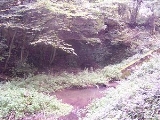
Butterley Tunnel
Encyclopedia
Butterley Tunnel is a one and three quarter mile long canal tunnel on the Cromford Canal
below Ripley
, in Derbyshire
, England
, opened to traffic in 1794.
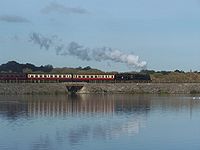 The tunnel was 2,966 yard (2712m) long, 9 ft (2.7 m) wide at water level, and 8 ft (2.4 m) from water to soffit
The tunnel was 2,966 yard (2712m) long, 9 ft (2.7 m) wide at water level, and 8 ft (2.4 m) from water to soffit
(depending on the water level). At the time of building it was the third longest canal tunnel
in the World after Sapperton
and Dudley
. Thirty-three shafts were sunk during construction with the workings dewatered using a Woodhouse steam engine. Water was provided for the Cromford Canal
from the 50 acres (202,343 m²) Butterley Reservoir
situated on the hill above the tunnel. The Butterley Reservoir is itself crossed by a stone railway embankment currently used by the locomotives of the Midland Railway - Butterley
's preserved steam railway. Water flowed from the reservoir directly into the tunnel via an adit
600 yards (548.6 m) along the tunnel from the Western Portal. Above the Eastern portal the Butterley Park Reservoir once provided water to the canal. This Reservoir was filled in during 1935. Both the tunnel and reservoirs were constructed by the Butterley Company
, formed in 1790 by Benjamin Outram
(1764–1805) and Francis Beresford (died 1801) with William Jessop
(1745–1814) and John Wright (1758–1840) joining by 1793.
There is no towpath
within the tunnel, which was for the most part only 9 feet (2.7 m) wide, therefore narrow boats
were propelled through the tunnel using the muscle power of the narrow boat's
crew. This process is called legging
. (The external link listed below shows men legging It through Butterley Tunnel.)
The sign illustrated (left) was displayed at both ends of the tunnel, and stressed the importance of only using the tunnel in any one direction at particular times. There are reported instances of fines levied for non-compliance with these rules.
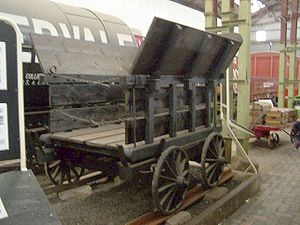 About 880 yards (804.7 m) from the tunnel's Western Portal there is an underground wharf
About 880 yards (804.7 m) from the tunnel's Western Portal there is an underground wharf
about 60 yards (54.9 m) long with the tunnel here widened to about 16 feet (4.9 m). One of the horizontal tunnels departing from the tunnel at this point used to run to the Butterley Company's Butterley Carr Pit which opened in 1812 and loaded its coal directly into narrow boats
at the underground wharf. There were also vertical shafts from the wharf which allowed goods in tram boxes to be lowered directly from and lifted up to the Butterley Company's works (on the hill above the tunnel) to and from the underground wharf. These tram boxes were used by Benjamin Outram
on the Little Eaton Tramway
. The box could be lifted from the tram chassis and loaded directly into narrow boats
or barges on the Derby Canal
. Similar designs were used in other undertakings in which Benjamin Outram
had an interest. Initially the boxes were lowered with the aid of a large water bucket descending or ascending a parallel shaft to act as a counter balance. This system was later replaced by a steam engine winding the boxes up and down the shafts. Reputable sources cited here consider the presence and mode of use of this underground wharf to be if not unique, extremely rare within the United Kingdom.
In the mid 1980s, demolition of the Butterley Company
's old foundry buildings exposed the original blast furnace
, dating to 1790. In front of the furnace is at least one vertical shaft, now capped off, which leads down to a short tunnel which connects with the canal tunnel close to the wharf area. Additionally, a number of deep drains below these buildings probably link to the canal tunnel. The site is now occupied by Butterley Engineering, one of the successors to the Butterley Company
, and noted for its involvement in the construction of the Falkirk Wheel
.
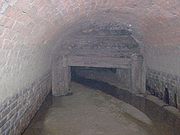 In 1889 subsidence
In 1889 subsidence
caused the tunnel to be closed for a period of four years with the tunnel reopening after repairs in 1893. This closure resulted in the permanent loss of some of the canal's customers to competing railway companies. A partial collapse of the Butterley Tunnel in 1900 due to mining related subsidence split the Cromford Canal
into two. The tunnel has not yet been repaired. Rudolph de Salis undertook a government funded survey of the tunnel in 1904 but his report was not favourable. Rudolph de Salis was a director of Fellows Morton and Clayton
, a prominent canal freight company. A third tunnel collapse in 1907 and a government report by Sir William Matthews KCMG
in June 1907 ended hopes of repairing the tunnel at this time and the tunnel was pronounced beyond economical repair in 1909. Commercial traffic on the canal ceased in 1944.
 "The Friends of Cromford Canal" is a group of volunteers whose aim is to fully restore the Cromford Canal and the Butterley Tunnel. A horse drawn narrowboat
"The Friends of Cromford Canal" is a group of volunteers whose aim is to fully restore the Cromford Canal and the Butterley Tunnel. A horse drawn narrowboat
is brought into service by "The Friends of Cromford Canal" occasionally on the only navigable section of the Cromford Canal
near to the Derbyshire village of Cromford
itself.
The tunnel has been extended twice since it was originally built. The Midland Railway's
Ripley
to Heanor
branch was built across the front of the Western portal with a new section of tunnel passing underneath bringing the total length at this time to 3063 yards (2801m). After the tunnels closure the A38 road
was built over the old railway track. The extra width required by the road brought about the introduction of an extra 6 in 8 in (2.03 m) wide, 20 yards (18.3 m) long cylindrical culvert to the Western end of the tunnel bringing the new length to about 3083 yards (2819m).
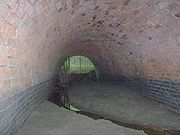 The Golden Valley Light Railway (GVLR) passes less than 30 yards (27.4 m) North of the tunnel's Eastern Portal. This 24 inches (609.6 mm) narrow gauge railway terminates at a station behind Newlands Inn approximately 100 yards (91.4 m) East of the Butterley Tunnel's Eastern Portal. This section of the GVLR's track crosses the site of the Butterley Park Reservoir. The GVLR operates for the benefit of tourists and is part of the Midland Railway - Butterley
The Golden Valley Light Railway (GVLR) passes less than 30 yards (27.4 m) North of the tunnel's Eastern Portal. This 24 inches (609.6 mm) narrow gauge railway terminates at a station behind Newlands Inn approximately 100 yards (91.4 m) East of the Butterley Tunnel's Eastern Portal. This section of the GVLR's track crosses the site of the Butterley Park Reservoir. The GVLR operates for the benefit of tourists and is part of the Midland Railway - Butterley
. The Newlands Inn served the Cromford Canal as a place where the narrow boat
horses were changed and probably where the narrow boat
crews were refreshed prior to or after legging it through the tunnel.
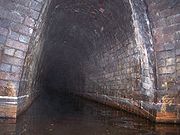
Cromford Canal
The Cromford Canal ran 14.5 miles from Cromford to the Erewash Canal in Derbyshire, England with a branch to Pinxton. Built by William Jessop with the assistance of Benjamin Outram, its alignment included four tunnels and 14 locks....
below Ripley
Ripley, Derbyshire
Ripley is a town in the Amber Valley area of Derbyshire in England.- Earliest history :Not much information is available as to when Ripley was founded, but it existed at the time of the Domesday Book, when it was held by a man called Levenot....
, in Derbyshire
Derbyshire
Derbyshire is a county in the East Midlands of England. A substantial portion of the Peak District National Park lies within Derbyshire. The northern part of Derbyshire overlaps with the Pennines, a famous chain of hills and mountains. The county contains within its boundary of approx...
, England
England
England is a country that is part of the United Kingdom. It shares land borders with Scotland to the north and Wales to the west; the Irish Sea is to the north west, the Celtic Sea to the south west, with the North Sea to the east and the English Channel to the south separating it from continental...
, opened to traffic in 1794.
Origins

Soffit
Soffit , in architecture, describes the underside of any construction element...
(depending on the water level). At the time of building it was the third longest canal tunnel
Canal tunnel
A canal tunnel is a tunnel for a canal. The biggest canal tunnel in the world is the Rove Tunnel in France. The oldest canal tunnel in the world is the Malpas Tunnel also in France, built in 1679. In the United States there is the Paw Paw Tunnel that opened in 1850.In some canal tunnels the towpath...
in the World after Sapperton
Sapperton Canal Tunnel
The Sapperton Canal Tunnel is a tunnel on the Thames and Severn Canal near Cirencester in Gloucestershire, England. It was the longest canal tunnel, and the longest tunnel of any kind, in England from 1789 to 1811....
and Dudley
Dudley Tunnel
Dudley Tunnel is a canal tunnel on the Dudley Canal Line No 1, England. At about long, it is now the second longest canal tunnel on the UK canal network today....
. Thirty-three shafts were sunk during construction with the workings dewatered using a Woodhouse steam engine. Water was provided for the Cromford Canal
Cromford Canal
The Cromford Canal ran 14.5 miles from Cromford to the Erewash Canal in Derbyshire, England with a branch to Pinxton. Built by William Jessop with the assistance of Benjamin Outram, its alignment included four tunnels and 14 locks....
from the 50 acres (202,343 m²) Butterley Reservoir
Butterley Reservoir
Butterley Reservoir is a reservoir in Derbyshire, England. The reservoir was built to provide water for the Cromford Canal which opened for use in 1794. The Codnor Park and Butterley Park reservoirs also provided water to the Cromford Canal. The currently disused Cromford Canal passes beneath the...
situated on the hill above the tunnel. The Butterley Reservoir is itself crossed by a stone railway embankment currently used by the locomotives of the Midland Railway - Butterley
Midland Railway - Butterley
The Midland Railway – Butterley is a heritage railway, formerly known until 2004 as the Midland Railway Centre, at Butterley, near Ripley in Derbyshire.-Overview:...
's preserved steam railway. Water flowed from the reservoir directly into the tunnel via an adit
Adit
An adit is an entrance to an underground mine which is horizontal or nearly horizontal, by which the mine can be entered, drained of water, and ventilated.-Construction:...
600 yards (548.6 m) along the tunnel from the Western Portal. Above the Eastern portal the Butterley Park Reservoir once provided water to the canal. This Reservoir was filled in during 1935. Both the tunnel and reservoirs were constructed by the Butterley Company
Butterley Company
Butterley Engineering was an engineering company based in Ripley, Derbyshire. The company was formed from the Butterley Company which began as Benjamin Outram and Company in 1790 and existed until 2009.-Origins:...
, formed in 1790 by Benjamin Outram
Benjamin Outram
Benjamin Outram was an English civil engineer, surveyor and industrialist. He was a pioneer in the building of canals and tramways.-Personal life:...
(1764–1805) and Francis Beresford (died 1801) with William Jessop
William Jessop
William Jessop was an English civil engineer, best known for his work on canals, harbours and early railways in the late 18th and early 19th centuries.-Early life:...
(1745–1814) and John Wright (1758–1840) joining by 1793.
There is no towpath
Towpath
A towpath is a road or trail on the bank of a river, canal, or other inland waterway. The purpose of a towpath is to allow a land vehicle, beasts of burden, or a team of human pullers to tow a boat, often a barge...
within the tunnel, which was for the most part only 9 feet (2.7 m) wide, therefore narrow boats
Narrowboat
A narrowboat or narrow boat is a boat of a distinctive design, made to fit the narrow canals of Great Britain.In the context of British Inland Waterways, "narrow boat" refers to the original working boats built in the 18th, 19th, and 20th centuries for carrying goods on the narrow canals...
were propelled through the tunnel using the muscle power of the narrow boat's
Narrowboat
A narrowboat or narrow boat is a boat of a distinctive design, made to fit the narrow canals of Great Britain.In the context of British Inland Waterways, "narrow boat" refers to the original working boats built in the 18th, 19th, and 20th centuries for carrying goods on the narrow canals...
crew. This process is called legging
Legging (canals)
Legging is a method of moving a boat through a canal tunnel or adit containing water.-Legging in canal tunnels:Early canal tunnels were built without a towpath as this would require a much larger bore, and hence cost more to build. Prior to the introduction of motorised boats, legging was one of...
. (The external link listed below shows men legging It through Butterley Tunnel.)
The sign illustrated (left) was displayed at both ends of the tunnel, and stressed the importance of only using the tunnel in any one direction at particular times. There are reported instances of fines levied for non-compliance with these rules.
Underground wharf

Wharf
A wharf or quay is a structure on the shore of a harbor where ships may dock to load and unload cargo or passengers.Such a structure includes one or more berths , and may also include piers, warehouses, or other facilities necessary for handling the ships.A wharf commonly comprises a fixed...
about 60 yards (54.9 m) long with the tunnel here widened to about 16 feet (4.9 m). One of the horizontal tunnels departing from the tunnel at this point used to run to the Butterley Company's Butterley Carr Pit which opened in 1812 and loaded its coal directly into narrow boats
Narrowboat
A narrowboat or narrow boat is a boat of a distinctive design, made to fit the narrow canals of Great Britain.In the context of British Inland Waterways, "narrow boat" refers to the original working boats built in the 18th, 19th, and 20th centuries for carrying goods on the narrow canals...
at the underground wharf. There were also vertical shafts from the wharf which allowed goods in tram boxes to be lowered directly from and lifted up to the Butterley Company's works (on the hill above the tunnel) to and from the underground wharf. These tram boxes were used by Benjamin Outram
Benjamin Outram
Benjamin Outram was an English civil engineer, surveyor and industrialist. He was a pioneer in the building of canals and tramways.-Personal life:...
on the Little Eaton Tramway
Little Eaton Gangway
The Little Eaton Gangway, or, to give it its official title, the Derby Canal Railway, was a narrow gauge industrial wagonway serving the Derby Canal, in England, at Little Eaton in Derbyshire.- The Derby Canal :...
. The box could be lifted from the tram chassis and loaded directly into narrow boats
Narrowboat
A narrowboat or narrow boat is a boat of a distinctive design, made to fit the narrow canals of Great Britain.In the context of British Inland Waterways, "narrow boat" refers to the original working boats built in the 18th, 19th, and 20th centuries for carrying goods on the narrow canals...
or barges on the Derby Canal
Derby Canal
The Derby Canal ran from the Trent and Mersey Canal at Swarkestone to Derby and Little Eaton, and to the Erewash Canal at Sandiacre, Derbyshire, England. The canal gained its Act of Parliament in 1793 and was fully completed in 1796...
. Similar designs were used in other undertakings in which Benjamin Outram
Benjamin Outram
Benjamin Outram was an English civil engineer, surveyor and industrialist. He was a pioneer in the building of canals and tramways.-Personal life:...
had an interest. Initially the boxes were lowered with the aid of a large water bucket descending or ascending a parallel shaft to act as a counter balance. This system was later replaced by a steam engine winding the boxes up and down the shafts. Reputable sources cited here consider the presence and mode of use of this underground wharf to be if not unique, extremely rare within the United Kingdom.
In the mid 1980s, demolition of the Butterley Company
Butterley Company
Butterley Engineering was an engineering company based in Ripley, Derbyshire. The company was formed from the Butterley Company which began as Benjamin Outram and Company in 1790 and existed until 2009.-Origins:...
's old foundry buildings exposed the original blast furnace
Blast furnace
A blast furnace is a type of metallurgical furnace used for smelting to produce industrial metals, generally iron.In a blast furnace, fuel and ore and flux are continuously supplied through the top of the furnace, while air is blown into the bottom of the chamber, so that the chemical reactions...
, dating to 1790. In front of the furnace is at least one vertical shaft, now capped off, which leads down to a short tunnel which connects with the canal tunnel close to the wharf area. Additionally, a number of deep drains below these buildings probably link to the canal tunnel. The site is now occupied by Butterley Engineering, one of the successors to the Butterley Company
Butterley Company
Butterley Engineering was an engineering company based in Ripley, Derbyshire. The company was formed from the Butterley Company which began as Benjamin Outram and Company in 1790 and existed until 2009.-Origins:...
, and noted for its involvement in the construction of the Falkirk Wheel
Falkirk Wheel
The Falkirk Wheel is a rotating boat lift located in Scotland, UK,connecting the Forth and Clyde Canal with the Union Canal, opened in 2002. It is named after the nearby town of Falkirk which is in central Scotland...
.
Decline in use

Subsidence
Subsidence is the motion of a surface as it shifts downward relative to a datum such as sea-level. The opposite of subsidence is uplift, which results in an increase in elevation...
caused the tunnel to be closed for a period of four years with the tunnel reopening after repairs in 1893. This closure resulted in the permanent loss of some of the canal's customers to competing railway companies. A partial collapse of the Butterley Tunnel in 1900 due to mining related subsidence split the Cromford Canal
Cromford Canal
The Cromford Canal ran 14.5 miles from Cromford to the Erewash Canal in Derbyshire, England with a branch to Pinxton. Built by William Jessop with the assistance of Benjamin Outram, its alignment included four tunnels and 14 locks....
into two. The tunnel has not yet been repaired. Rudolph de Salis undertook a government funded survey of the tunnel in 1904 but his report was not favourable. Rudolph de Salis was a director of Fellows Morton and Clayton
Fellows Morton and Clayton
Fellows Morton & Clayton Ltd was, for much of the early 20th century, the largest and best-known canal transportation company in England. The company was in existence from 1889 to 1947.-Origins:...
, a prominent canal freight company. A third tunnel collapse in 1907 and a government report by Sir William Matthews KCMG
Order of St Michael and St George
The Most Distinguished Order of Saint Michael and Saint George is an order of chivalry founded on 28 April 1818 by George, Prince Regent, later George IV of the United Kingdom, while he was acting as Prince Regent for his father, George III....
in June 1907 ended hopes of repairing the tunnel at this time and the tunnel was pronounced beyond economical repair in 1909. Commercial traffic on the canal ceased in 1944.
After closure

Narrowboat
A narrowboat or narrow boat is a boat of a distinctive design, made to fit the narrow canals of Great Britain.In the context of British Inland Waterways, "narrow boat" refers to the original working boats built in the 18th, 19th, and 20th centuries for carrying goods on the narrow canals...
is brought into service by "The Friends of Cromford Canal" occasionally on the only navigable section of the Cromford Canal
Cromford Canal
The Cromford Canal ran 14.5 miles from Cromford to the Erewash Canal in Derbyshire, England with a branch to Pinxton. Built by William Jessop with the assistance of Benjamin Outram, its alignment included four tunnels and 14 locks....
near to the Derbyshire village of Cromford
Cromford
Cromford is a village, two miles to the south of Matlock in the Derbyshire Dales district in Derbyshire, England. It is principally known for its historical connection with Richard Arkwright, and the Cromford Mill which he built here in 1771...
itself.
The tunnel has been extended twice since it was originally built. The Midland Railway's
Midland Railway
The Midland Railway was a railway company in the United Kingdom from 1844 to 1922, when it became part of the London, Midland and Scottish Railway....
Ripley
Ripley, Derbyshire
Ripley is a town in the Amber Valley area of Derbyshire in England.- Earliest history :Not much information is available as to when Ripley was founded, but it existed at the time of the Domesday Book, when it was held by a man called Levenot....
to Heanor
Heanor
Heanor is a town in the Amber Valley district of Derbyshire in the East Midlands of England. It is northeast of Derby. According to the census of 2001 the town's population was 22,620.-History:...
branch was built across the front of the Western portal with a new section of tunnel passing underneath bringing the total length at this time to 3063 yards (2801m). After the tunnels closure the A38 road
A38 road
The A38, part of which is also known as the Devon Expressway, is a major A-class trunk road in England.The road runs from Bodmin in Cornwall to Mansfield in Nottinghamshire. It is long, making it one of the longest A-roads in England. It was formerly known as the Leeds — Exeter Trunk Road,...
was built over the old railway track. The extra width required by the road brought about the introduction of an extra 6 in 8 in (2.03 m) wide, 20 yards (18.3 m) long cylindrical culvert to the Western end of the tunnel bringing the new length to about 3083 yards (2819m).

Midland Railway - Butterley
The Midland Railway – Butterley is a heritage railway, formerly known until 2004 as the Midland Railway Centre, at Butterley, near Ripley in Derbyshire.-Overview:...
. The Newlands Inn served the Cromford Canal as a place where the narrow boat
Narrowboat
A narrowboat or narrow boat is a boat of a distinctive design, made to fit the narrow canals of Great Britain.In the context of British Inland Waterways, "narrow boat" refers to the original working boats built in the 18th, 19th, and 20th centuries for carrying goods on the narrow canals...
horses were changed and probably where the narrow boat
Narrowboat
A narrowboat or narrow boat is a boat of a distinctive design, made to fit the narrow canals of Great Britain.In the context of British Inland Waterways, "narrow boat" refers to the original working boats built in the 18th, 19th, and 20th centuries for carrying goods on the narrow canals...
crews were refreshed prior to or after legging it through the tunnel.
See also
- List of canal tunnels in Great Britain
- ButterleyButterleyButterley is a village in the English county of Derbyshire near to Ripley. It is the site of the Midland Railway - Butterley, as well as the old Butterley Brickworks.- Notable residents :...
- Worsley Navigable LevelsWorsley Navigable LevelsThe Worsley Navigable Levels are an extensive series of coal mines in Worsley in the City of Salford in Greater Manchester, England. They were worked largely by the use of underground canals and boats called starvationers....
- Speedwell CavernSpeedwell CavernThe Speedwell Cavern is one of the four show caves in Castleton, Derbyshire, England.It consists of a horizontal lead miners' adit leading to the cavern itself, a limestone cave...
- Wet Earth CollieryWet Earth CollieryThe Wet Earth Colliery has a unique place in British coal mining history, apart from being one of the earliest pits in the country; it is the place where the engineer James Brindley made water run uphill...
Further reading

External links
- Map sources: western portal, and eastern portal,

